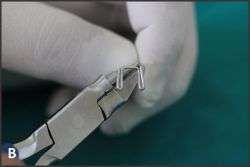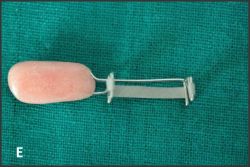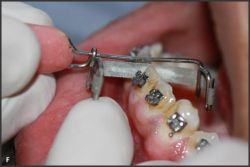|
|
|
| 'c' Interproximal Strip Holder |
Vineet Kumar 1 , (Major) Narinder Pahwa 2 , Yogesh Tokas 3 , Sunanda Roy Choudhary 4
1 Reader, Department of Orthodontics - S.B.B. Dental College, Ghaziabad, India.
2 Senior Lecturer, Department of Orthodontics - S.B.B. Dental College, Ghaziabad, India.
3 Senior Lecturer, Department of Orthodontics - S.B.B. Dental College, Ghaziabad, India.
4 Professor and Head, Dept of Orthodontics - S.B.B Dental College, Ghaziabad, India.
|
| Address For Correspondence |
Dr. Vineet Kumar
29/103, East End apartments,
Mayur vihar phase 1 ext.
Delhi 110096
Mobile no.09899347846
Email: vkorth_32@yahoo.co.in |
| Abstract |
| Interproximal reduction to remove proximal enamel is a procedure which is frequently carried out in cases of mild crowding usually in the lower anterior region and involves the removal of 2-4 mm of enamel1. Radiographs are taken so that the clinician can determine the convexity of each proximal surface, thickness of enamel on each tooth and the disposition of the roots2. Proximal reproximation is also done when finishing a case. Flattening lower incisor contact points by slenderizing or stripping creates flat contact surfaces that help resist labiolingual crown displacement and it also helps to eliminate the need for lower incisor retention3. Different modalities to carry out interproximal reduction of the enamel are given in the literature. This article will describe an economical, easy to fabricate interproximal strip holder that can be fabricated by any general dentist and can be used for reproximation of teeth. |
|
| Keywords |
| Interproximal, proximal, crown displacement, labiolingual, reproximation |
|
| Full Text |
Introduction
Interproximal enamel reduction is a very simple clinical procedure at the hands of a well trained clinician. It involves the reduction, anatomic recontouring and protection of proximal enamel surfaces of permanent teeth[4]. This procedure of enamel reduction is also known as proximal slicing, reapproximation and slenderization. This procedure is frequently carried out in cases of mild crowding usually in the lower anterior region and involves the removal of 2-4 mm of enamel[1]. Also proximal enamel reduction can be done to stabilize the occlusion after orthodontic treatment by creating more stable contact surfaces that help resist labiolingual crown displacement and it help to eliminate the need for lower incisor retention[3]. Interproximal enamel reduction is a procedure which requires precision and control so that the actual morphology of the tooth is not altered also indiscriminate enamel removal may lead to hypersensitivity and proximal caries. Therefore this procedure should be carried out with utmost care. Over the years different methods of interproximal enamel reduction have been developed. These include Airotor stripping by Sheridan1 and manually with the help of interproximal strip holders. This article will describe "C" interproximal strip holder which is an economical, easy to fabricate interproximal strip holder that can be fabricated by any general dentist and can be used for reproximation of teeth.
Design:
It is a device made up of 19 gauge stainless steel wire with two loops on either ends to secure the metallic strip and a handle. This makes it convenient for the operator to work with and is comfortable for the patient.
Fabrication:
"C" interproximal strip holder can be easily fabricated with a universal plier. (A). It made up of 19 gauge stainless steel wire.
1. Firstly 2 loops (6mm in length) are formed at a distance of 6mm to each other in the same plane. (B)
2. Then wire is bent 900 just next to second loop to fabricate horizontal connecting arm and handle. ©
3. Handle should be fabricated 20 mm from the first 2 loops.
4. After forming handle the wire is crossed over the horizontal connecting arm to fabricate the next 2 loops. (D)
5. Second set of loops should be of same dimensions and are formed parallel to first 2 loops.
6. Handle can be embedded in mix of cold cure acrylic for easy grip and smooth action
7. Up to 5mm width interproximal strip can be snugly fitted to all four loops like a 'C'. (E)
8. Free end of strip is pulled from one side to make it taut.
Both safe sided and double sided strip can be snugly fitted. Although distance between the two sets of loops can be increased without compromising the tautness, it is made 20mm apart to prevent trauma to the tongue while moving it in a to and fro motion. (F)
Discussion:
Interproximal enamel reduction is an important procedure used by orthodontists to relieve mild crowding in the lower anterior region. Peck and peck came up with an index in the 1970s. They advised stripping whenever the mesiodistal dimension of the mandibular incisor did not fall within acceptable figures as calculated from the index[5]. The technique of interproximal reduction was revolutionised by Sheridan with the introduction of airotor stripping[6]. Important indications for interproximal enamel reduction are tooth size discrepancy, interarch discrepancy, tooth shape and dental esthetics, macrodontia,
 | Figure 1 A. Material Required And Steps In Fabrication Of Appliance.
 |
 | Figure 1 B. Material Required And Steps In Fabrication Of Appliance.
 |
 | Figure 1 C. Material Required And Steps In Fabrication Of Appliance.
 |
 | Figure 1 D. Material Required And Steps In Fabrication Of Appliance.
 |
 | Figure 1 E. Material Required And Steps In Fabrication Of Appliance.
 |
 | Figure 1 F. Material Required And Steps In Fabrication Of Appliance.
 |
and to enhance retention and stability[7]. However there are few contraindications to the procedure such as caries susceptibility, poor oral hygiene, severe crowding and hypersensitivity to cold[7].
The amount of enamel that can be removed and the amount of space generated as suggested by Sheridan is if 50% of interproximal enamel is removed 6.4 mm of space can be generated from the 8 buccal contacts (0.8mm/ contact) and 2.5 mm of space can be created from 5 anterior contacts (0.5mm/ contact). So a total cumulative gain of 8.9 mm of the space is feasible[6].
'C' interproximal strip holder is a simple, easy to fabricate and sturdy device which can be used to perform the enamel reduction. Its use is easy to master and above all it can be sterilized in an autoclave and reused. It has got certain disadvantages such as it requires more time and abrasive strips have to be changed frequently. However it has got certain advantages such as the margin of error in the hands of a new operator is much less as compared to Airotor stripping also the chances of altering tooth morphology and dentinal exposure are fewer with the "C" interproximal strip holder.
Proper treatment planning must be done before carrying out the procedure. Complete set of radiographs and models is needed. The orthodontist must decide how much enamel can be removed so that a sufficient amount of enamel is left to form a proper contact point and avoid root contact[7]. When a tooth is rotated proximal surface should be reduced rather than the contact area.
Conclusion:
Proper treatment planning should be done before carrying out the procedure as it requires precision. Sufficient amount of enamel should be left on the proximal surface to avoid dentinal exposure. When done properly enamel reduction with the 'C' interproximal strip holder will fulfil all these criteria.
References:
1. John J. Sheridan: Air-Rotor Stripping Update. J Clin Orthod 1987; 781 - 788
2. Julien Philippe: A Method of Enamel Reduction for Correction of Adult Arch-Length Discrepancy. J Clin Orthod 1991; 484 - 489
3. Raleigh Williams: Eliminating Lower Retention. J Clin Orthod 1985; 342 - 349
4. Peck H and Peck S: An index for assessing tooth shape deviations as applied to the mandbular incisors. Am J Orthod 1972; 61: 384-01.
5. Peck H and Peck S: crown dimensions and mandibular incisor alignment. Angle Orthod 1972; 42: 148-53.
6. Sheridan JJ. Airotor stripping. J Clin Orthod 1985; 19: 43-49.
7. Sandhya Jadhav et al: Interproximal enamel reduction in comprehensive orthodontic treatment: A review. Indian J Stomatol 2011; 2(4): 245-58. |
|
|
|
|
|
|